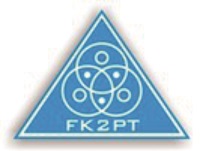Optimum Koi Herpesvirus DNA Extraction from the Aquaculture Water
Abstract
Koi Herpesvirus (KHV) is one of the viral fish disease in the common carp aquaculture. At present, KHV diagnoses is performed using Polymerase Chain Reaction (PCR) method. However, the effort to extract DNA viruses from environmental samples depends on two fundamental problems: inhibition of the extraction and amplification processes and a very small number of viruses. The small amount of virus load in the water requires a concentration process before further molecular analysis. In this study, the sensitivity of three methods of extraction and purification of viral genetic material from the water, namely deposition with PEG, filtration-elution, and flocculation with antibodies for the detection of KHV from the water with the PCR method was performed. Water samples were collected from Cirata reservoir, West Java which is a site location for carp aquaculture. The organic flocculation cannot be carried out in the present study because anti-KHV antibodies cannot be produced. This is because the amount of virus in the sample used by the vaccine is low. Meanwhile, the precipitation method with PEG cannot produce DNAextract’s although quantity and purity are good enough to be amplified. For the filtration-elution method, both with and without the reconcentration process, a clear band of DNA can be produced after amplification. In conclusion, the filtration-elution method is considered as the most suitable method in obtaining KHV DNA’s taken from the water samples.
Keywords
Full Text:
PDFReferences
Adkison, M., Gilad, O., & Hedrick, R. (2005). An Enzyme Linked Immunosorbent Assay (ELISA) for Detection of Antibodies to the Koi Herpesvirus (KHV) in the Serum of Koi Cyprinus carpio. Fish Pathology, 40, 53-62. doi:10.3147/jsfp.40.53
Aoki, T., Hirono, I., Kurokawa, K., Fukuda, H., Nahary, R., Eldar, A., . . . Hedrick, R. (2007). Genome Sequences of Three Koi Herpesvirus Isolates Representing the Expanding Distribution of an Emerging Disease Threatening Koi and Common Carp Worldwide. Journal of Virology, 81, 5058-5065. doi:10.1128/JVI.00146-07
Bercovier, H., Fishman, Y., Nahary, R., Sinai, S., Zlotkin, A., Eyngor, M., . . . Hedrick, R. (2005). Cloning of the Koi Herpesvirus (KHV) gene encoding thymidine kinase and its use for a highly sensitive PCR based diagnosis. BMC Microbiology, 5, 13. doi:10.1186/1471-2180-5-13
Dishon, A., Perelberg, A., Bishara-Shieban, J., Ilouze, M., Davidovich-Cohen, M., Werker, S., & Kotler, M. (2005). Detection of Carp Interstitial Nephritis and Gill Necrosis Virus in Fish Droppings. Applied and Environmental Microbiology, 71, 7285-7291. doi:10.1128/AEM.71.11.7285-7291.2005
Gilad, O., Yun, S., Zagmutt, F., Leutenegger, C., Bercovier, H., & Hedrick, R. (2004). Concentration of a Koi herpesvirus (KHV) in tissues of experimentally infected Cyprinus carpio koi as assessed by real-time TaqMan PCR. Diseases of Aquatic Organisms, 60, 179-187. doi:10.3354/dao060179
Gray, W., Mullis, L., LaPatra, S., Groff, J., & Goodwin, A. (2002). Detection of Koi herpesvirus DNA in tissues of infected fish. Journal of Fish Diseases, 25, 171-178. doi:10.1046/j.1365-2761.2002.00355.x
Gunimaladevi, I., Kono, T., Venugopal, M., & Sakai, M. (2004). Detection of koi herpesvirus in common carp, Cyprinus carpio L., by loop-mediated isothermal amplification. Journal of Fish Diseases, 27, 583-589. doi:10.1111/j.1365-2761.2004.00578.x
Haramoto, E., Kitajima, M., Katayama, H., & Ohgaki, S. (2007). Detection of koi herpesvirus DNA in river water in Japan. Journal of Fish Diseases, 30, 59-61. doi:10.1111/j.1365-2761.2007.00778.x
Hill, W., Jakubowski, W., Akin, E., & Clarke, N. (1976). Detection of virus in water: sensitivity of the tentative standard method for drinking water. Applied and Environmental Microbiology, 31, 254-261. doi:10.1128/AEM.31.2.254-261.1976
Lewis, G., & Metcalf, T. (1988). Polyethylene glycol precipitation for recovery of pathogenic viruses, including hepatitis A virus and human rotavirus, from oyster, water, and sediment samples. Applied and Environmental Microbiology, 54, 1983-1988. doi:10.1128/AEM.54.8.1983-1988.1988
Matsui, K., Honjo, M. I. E., Kohmatsu, Y., Uchii, K., Yonekura, R., & Kawabata, Z. I. (2008). Detection and significance of koi herpesvirus (KHV) in freshwater environments. Freshwater Biology, 53(6), 1262-1272. doi:https://doi.org/10.1111/j.1365-2427.2007.01874.x
Moreira, D. (1998). Efficient removal of PCR inhibitors using agarose-embedded DNA preparations. Nucleic Acids Research, 26(13), 3309-3310. doi:10.1093/nar/26.13.3309
Perelberg, A., Smirnov, R., Hutorian, M., Diamant, A., Bejerano, Y., & Kotler, M. (2003). Epidemiological description of a new viral disease afflicting cultured Cyprinus Carpio in Israel. The Israeli journal of aquaculture = Bamidgeh, 55, 5-12.
Queiroz, A. P. S., Santos, F. M., Sassaroli, A., Hársi, C., Monezi, T., & Mehnert, D. (2001). Electropositive Filter Membrane as an Alternative for the Elimination of PCR Inhibitors from Sewage and Water Samples. Applied and Environmental Microbiology, 67, 4614-4618. doi:10.1128/AEM.67.10.4614-4618.2001
Schwab, K., Leon, R., & Sobsey, M. (1996). Immunoaffinity concentration and purification of waterborne enteric virus for detection by reverse transcriptase PCR. Applied and Environmental Microbiology, 62, 2086-2094. doi:10.1128/AEM.62.6.2086-2094.1996
Soliman, H., & El-Matbouli, M. (2005). An inexpensive and rapid diagnostic method of Koi Herpesvirus (KHV) infection by loop-mediated isothermal amplification. Virology Journal, 2(1), 83. doi:10.1186/1743-422X-2-83
Sunarto, A., Rukyani, A., & Itami, T. (2005). Indonesian Experience on the Outbreak of Koi Herpesvirus in Koi and Carp (Cyprinus carpio). Bull Fish Res Agency Suppl, 2.
DOI: http://dx.doi.org/10.33512/jpk.v11i2.12527
Refbacks
- There are currently no refbacks.



_-_Copy1.png)